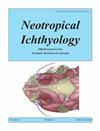马塔大西洋东北部淡水生态区短尾蝗(特征:蝗科)的系统地理学研究
IF 2
4区 生物学
Q1 ZOOLOGY
引用次数: 0
摘要
东北Mata atlntica淡水生态区(NMAF)以其鱼类区系的高度地方性而闻名,其进化和生物地理历史仍然知之甚少。Oligosarcus acutirostris是NMAF特有的淡水鱼,分布在巴西东部巴伊亚州、Espírito Santo和米纳斯吉拉斯州部分地区的沿海河流和溪流中。它在NMAF沿线目前孤立的河流流域的广泛分布促使了这项研究,旨在了解哪些情景将涉及确定其当前分布模式,并有助于更好地理解NMAF的生物地理历史。为此,我们分析了沿物种分布的不同地点的样本的线粒体和核DNA序列,包括其类型位置。总体而言,系统地理分析表明,物种内部具有很强的遗传结构,这主要体现在所分析的大多数盆地之间的单倍型不共享。根据AMOVA结果,单倍型的当前分布可以用更新世沿海古水系来解释。这些结果也被用来测试和补充先前提出的关于NMAF排水的生物地理学假设。本文章由计算机程序翻译,如有差异,请以英文原文为准。
Phylogeography of Oligosarcus acutirostris (Characiformes: Characidae): testing biogeographic hypotheses in the Northeastern Mata Atlântica freshwater ecoregion
Abstract The Northeastern Mata Atlântica freshwater ecoregion (NMAF) is recognized for the high degree of endemism of its ichthyofauna, whose evolutionary and biogeographic histories are still poorly understood. Oligosarcus acutirostris is a freshwater fish species endemic to the NMAF, which is distributed in coastal rivers and streams draining Bahia, Espírito Santo, and part of Minas Gerais states in eastern Brazil. Its widespread distribution in currently isolated river basins along the NMAF prompted this study, which aimed to understand what scenarios would be involved in determining its current distribution pattern, and to contribute to a better understanding of the biogeographic history of the NMAF. For this, mitochondrial and nuclear DNA sequences were analyzed based on samples from different localities along the species distribution, including its type locality. Overall, phylogeographic analyses indicate a strong genetic structure within the species evidenced mainly by the non-sharing of haplotypes between most of the basins analyzed. According to the AMOVA results, the current distribution of haplotypes is better explained by the Pleistocene coastal paleodrainages. The results are also used to test and complement a biogeographic hypothesis previously proposed for the drainages of the NMAF.
求助全文
通过发布文献求助,成功后即可免费获取论文全文。
去求助
来源期刊

Neotropical Ichthyology
生物-动物学
CiteScore
2.80
自引率
17.60%
发文量
24
审稿时长
6-12 weeks
期刊介绍:
Neotropical Ichthyology is the official journal of the Sociedade Brasileira de Ictiologia (SBI). It is an international peer-reviewed Open Access periodical that publishes original articles and reviews exclusively on Neotropical freshwater and marine fishes and constitutes an International Forum to disclose and discuss results of original research on the diversity of marine, estuarine and freshwater Neotropical fishes.
-Frequency: Four issues per year published only online since 2020, using the ‘rolling pass’ system, which posts articles online immediately as soon as they are ready for publication. A searchable and citable Digital Object Identifier (DOI) is assigned to each article immediately after online publication, with no need to await the issue’s closing.
-Areas of interest: Biology, Biochemistry and Physiology, Ecology, Ethology, Genetics and Molecular Biology, Systematics.
-Peer review process: The Editor-in-Chief screens each manuscript submitted to Neotropical Ichthyology to verify whether it is within the journal’s scope and policy, presents original research and follows the journal’s guidelines. After passing through the initial screening, articles are assigned to a Section Editor, who then assigns an Associate Editor to start the single blind review process.
 求助内容:
求助内容: 应助结果提醒方式:
应助结果提醒方式:


